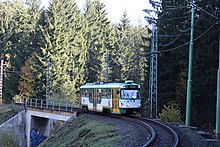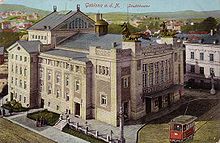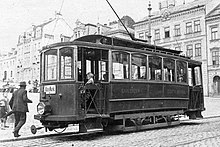Tram Jablonec nad Nisou
The tram Jablonec nad Nisou was a meter-gauge tram company in today's Czech Republic . The network opened up the city of Jablonec nad Nisou ( Gablonz an der Neisse ) with its suburbs and also led to Janov nad Nisou ( Johannesberg ), Rychnov ( Reichenau ) and Liberec ( Reichenberg ). Tram traffic in the city network was stopped on March 31, 1965 after extremely heavy snowfalls and never resumed afterwards. Today only the overland line Liberec – Jablonec nad Nisou with its peripheral end point "Tyršovy sady" still exists .
With a maximum gradient of 108.5 per mille , the Jablonec nad Nisou tram network was the steepest section of a tram in Czechoslovakia and today's Czech Republic .
history
Prehistory and construction
When the south-north German connecting line was built in 1859, Gablonz was not taken into account for topographical reasons. The next train station on the line was in Reichenau, about five kilometers as the crow flies. The Reichenberg – Gablonz local railway , which opened in 1893, was also only able to improve the traffic conditions insignificantly. At that time, the Gablonz factory owner Gustav Hoffmann developed a project to set up an electrically operated small railway network, which was presented to the public on November 27, 1895. Two lines with an operating length of 21.310 kilometers were planned.
Gustav Hoffmann received the concession “ to build and operate a narrow-gauge small railway in the area of the city of Gablonz and the surrounding area ” on September 6, 1898. Part of the concession was the obligation to start construction of the line immediately after receiving the building permit and to be completed within a year and a half. The duration of the concession was set for 60 years until September 6, 1958. In the same year, construction work began by the Stumm von Trauenfels company .
On June 13, 1899, the Gablonzer tram and electricity company was founded as an operator. The first section was officially opened on February 7, 1900, and the entire network was completed in September 1900. The routes were consistently single-tracked on the side of the road with a turnout. The central depot was in Gablonz on Wiener Straße, a smaller car hall at the end of Johannesberg. The steepest section of the route network was in Gablonzer Gewerbegasse (today: Kubálkova). It had a gradient of 108.5 per thousand over a length of 60 meters .
Opening dates:
- February 7, 1900: Reichenau-Alter Markt (9.310 km)
- April 4, 1900: Lindengasse – Alter Markt – Neudorfer Straße (1.72 km)
- May 10, 1900: Brandl – Lindengasse (1.37 km)
- May 12, 1900 Alter Markt – Reinowitz (3.0 km)
- September 5, 1900: Reinowitz – Johannesberg (3.188 km) and Brandl – Reinowitz (2.249 km)
- September 27, 1900: Wiener Straße – Hauptbahnhof (0.420 km)
On August 17, 1904, the Gablonzer Straßenbahn- und Elektrizitätsgesellschaft received the license to expand the network from Neudorfer Straße to Schlag . The line was opened on September 1, 1904, and construction had already begun on June 12, 1904. The tram company now operated as Gablonzer Electric Railways , or GEB for short
From then on, the following lines with a total length of 22.775 km were served:
- Reichenau – Puletschnei – Kukan – Seidenschwanz – Alter Markt – Grünwald – Reinowitz – Lautschnei – Johannesberg
- Brandl – Alter Markt – Schlag
- Hauptbahnhof – Alter Markt – Schlag
Since 1904, the Brandl – Reinowitz route has only been used for freight traffic.
business
After the break-up of Austria-Hungary as a result of the First World War, Gablonz was on the territory of the newly founded state of Czechoslovakia , although the population demanded that they remain with Austria due to the self-determination proclaimed by Woodrow Wilson . For rail operations, this meant the introduction of consistent bilingualism in spite of the small Czech population in the transport area, whereby the Czech language had to come first. For example, the destination signs on the trams have been supplemented accordingly.
The municipality of Gablonz acquired the majority of the shares on December 5, 1922. From then on, the company traded as Gablonzer Verkehrsgesellschaft AG - Gablonzer Electric Railways (Jappencká dopravní společnost as - Jappencké elektrické dráhy). The complete renewal of the tracks began on August 1, 1924, and was now completely aluminothermally welded . Tight track curves were widened and provided with transition curves. The locomotives were successively equipped with modern pantographs, after which the pole-type pantographs had already been replaced by bow-type pantographs in 1918. At that time, the first plans to build a new line to Reichenberg were made in order to connect the two meter-gauge networks.
On September 28, 1926, with the commissioning of new vehicles, a new timetable with shorter travel times came into force. There were now express trips between Gablonz, Alter Markt and Reichenau with only one stop in Kukan, which made the connection to the express train to and from Prague.
In March 1928, the city council decided to rebuild the line to the train station, which was completed by September 1928. The carriages of the line to Schlag always started at the station, the Brandl terminus was only served with a few shuttles following the ČSD trains.
- Line network from September 1, 1929
| line | course | Tact |
|---|---|---|
| 1 | Reichenau - Puletschnei - Kukan - Wiener Strasse - Old Market - Grünwald - Reinowitz - Johannesberg Rychnov - Pulečný - Kokonín - Vídeňská - Staré náměstí - Mšeno - Rýnovice - Honsberk |
20 min |
| 2 | Main Railway Station - Main Post Office - Old Market - Hlavní nádraží - Hlavní Pošta - Staré náměstí - Paseky |
10 min |
| - | Brandl - Main Post Office (only shuttle trips to and from ČSD trains) Brandl - Hlavní Pošta |
- |
From October 1, 1938, the Sudetenland and thus also Gablonz were on German territory as a result of the Munich Agreement . On the day of the occupation of the city by the Wehrmacht , the right-hand drive law , which is common in the German Reich, was introduced in road traffic and thus also in the tram. The Czech signs disappeared again. On June 1, 1940, passenger traffic between Bürgerstraße, hospital and Brandl was stopped, but the route remained in operation for freight traffic. From then on, shuttle cars served the Hauptpost – Bürgerstrasse line every hour.
On May 8, 1945 Gablonz fell back to Czechoslovakia and a large part of the German-Bohemian residents of the city were expelled from the country until 1948. From then on only the Czech names were valid.
Under the Czech administration, concrete plans for the construction of the line to Liberec began soon after the end of the war. A first pre-concession was issued for this in 1947 and in 1948 the transport companies of both cities were administratively combined. Construction work on the new route began in 1950 from Jablonec. On November 16, 1953, the section from Jablonec to Proseč and on February 15, 1954 to Vratislavice, Kostel was opened. On January 1, 1955, the line was fully operational as line 11 from Jablonec, Pražská to Liberec, Fügnerova. For the operation of the line 11 six rounds were required, which were provided proportionally by both tram operators.
- Line network from January 1, 1955
| line | course |
|---|---|
| 1 | Rychnov - Pulečný - Kokonín - Pražská - Mírové náměstí - Mšeno - Rýnovice - Janov |
| 2 | Hlavní nádraží - Mírové náměstí - Paseky |
| 3 | Kokonín, výhybna - Pražská - Mírové náměstí - Mšeno (reinforcement line in rush hour) |
| 11 | Pražská - Brandl - Proseč - Vratislavice - Liberec, Fügnerova |
In 1957, test drives with the prototype of the modern 2.50 meter wide one-way wagon of the Tatra T2 type were carried out on line 11 . In preparation for the planned service on Line 1, the Rychnov terminal was given a turning loop in 1958 and the Janov terminal was given a triangle of tracks in 1962 . In 1960 the transport companies of the two cities, which were combined in 1948, were split up again into two independent companies. The infrastructure border on the overland line 11 was from now on at the Proseč siding.
Decline and shutdown
The network was first reduced on February 20, 1959, when line 2 between the train station and Paseky had to be abandoned due to worn tracks and replaced by an urban bus line. Reinforcement line 3 between Kokonín, výhybna and Mšeno was closed on July 1, 1963. The clock on line 1 between Rychnov and Janov has been stretched from 20 to 30 minutes after some evasions have been modified. After heavy snowfall, tram operations had to be completely stopped on March 31, 1965. From then on, buses operated as substitutes. Only line 11 remained in operation.
Since January 1, 1970, the vehicles for the operation of the overland line have been provided exclusively by the Liberec transport company. This effectively ended the existence of the Jablonec tram as an independent tram company. The Jablonec transport company was dissolved on December 31, 1980, and ČSAD Ústí nad Labem took over urban bus transport .
Continued operation of the overland line to Liberec

The route of line 11 was so worn out in the early 1970s that a comprehensive renovation was necessary. On March 27, 1972, tram traffic was temporarily suspended. In the years that followed, the sections with their own railway structure were fitted with a sleeper superstructure and a new overhead contact line with catenaries throughout, which allows higher speeds. In Jablonec, the previous block bypass with the end point in Pražská was replaced by the new Tyršovy sady loop. With this shortening of the route, the last remaining track sections of the old Gablonzer tram disappeared. On December 29, 1976, the renewed line went back into operation. Since then it has been used exclusively with Tatra one-way vehicles .
Since the velvet revolution in 1989 , there have been repeated efforts to extend the tram line back into the city center and beyond. The now obsolete Regiotram Nisa project even provided for the connection of new tram routes with the railroad using the tram-train system.
Since 1990 the tram routes in Liberec have been converted to regular gauge. In order not to have to switch over the entire network simultaneously, three-rail tracks were built in sections and re-gauged sleepers were installed. As of 2020, the overland route from Liberec to Vratislavice has also been prepared for the renovation and has been expanded to two-track almost entirely. Due to the lack of clarity about the continued operation of the line over the city limits to Jablonec, this has not been done there so far.
A current project provides for an extension of 800 meters through the Soukenná and via the Lower Market (Dolní Náměstí) to a new end point on the Kamenná, where a new transfer terminal between trams, intercity buses and rail is planned. The total cost of 1.2 billion crowns is to be financed largely through a support program of the European Union. Disputes between Liberec and Jablonec about the division of the operating costs incurred delay implementation time and again. The planning is based on the assumption that a new building will be in the normal course.
Depots
- Gablonz, Wiener Straße / Jablonec, Pražská
The central tram depot “Bahnhof Wiener Straße” was located on Wiener Straße and was expanded several times during its service life. There was a general cargo shed for handling goods. In 1926 a new workshop was built. Until 1972 the depot was still used for tram operation, at last only one track for nighttime storage of the Liberec tram trains. Today it is structurally unchanged and serves as a bus depot.
- Johannesberg / Janov
At the end of Johannesberg there was a single-track shed in which two cars could be placed one behind the other. The distinctive half-timbered building was demolished after operations were closed.
- Waxwing / Vrkoslavice
The wagon hall in Waxwing was built in 1929. It had three tracks and was used to store electric locomotives and freight cars until 1950. The building and remains of track outside are still in a desolate condition today.
Freight transport
With the opening of the Reichenau transshipment point on November 20, 1902, the Jablonec nad Nisou tram network also saw brisk freight traffic. Reloading facilities were also set up at Gablonz train station and in Brandl. Two electric locomotives and at times up to 54 (!) Freight trailers were available for this. Public loading points were set up in 1903 in Seidenschwanz, Puletschnei, Kukan, Reinowitz and Johannesberg. Various industrial companies were also directly connected with sidings.
From January 1, 1904, the small electric railway also took over the transport of mail for the post offices in the railway area, for which the three post offices in Gablonz received their own sidings. From 1906 to 1909, the tram also took over the transport of materials for the construction site of the Grünwalder Dam .
Freight traffic ceased in the years after the Second World War, when a serious economic decline set in as a result of the expulsion of the German-speaking population . The mail service was given up in May 1945 with the end of the war, the remaining goods transport ended on February 15, 1954.
vehicles
Initially, the Gablonzer tram had 16 two-axle railcars, five closed and five open (summer) sidecars, which had been delivered by the Grazer Waggonfabrik between 1899 and 1900. The railcars had half-open platforms and offered space for 32 passengers. Six cars received new car bodies from Ringhoffer in 1930 . The cars were retired by the end of the 1950s.
In 1902, the Grazer Waggonfabrik delivered another four railcars with more powerful engines and a larger wheelbase, but otherwise largely resembled the first series. Equipped with more powerful engines in 1920, they were used until the 1950s.
Ringhoffer in Prague built ten railcars in 1925/26 and two again in 1930, as well as four trailer cars. The railcars had completely closed platforms and a significantly higher performance. As a special feature, the railcars delivered in 1930 were equipped with free steering axles for better curve travel. They were retired in the early 1960s.
After the Second World War, the vehicle fleet was renewed from 1952 with eight two-axle Tatra 6MT tramcars , which were supplied by the Česká Lípa wagon factory. Another twelve cars of this type were taken over by the Most tram in 1959 . Jablonec no longer received modern four-axle wagons of the types Tatra T2 and Tatra T3 .
The railcar No. 117 of the type 6MT and the sidecar No. 44 from the year of construction 1930 have been preserved in the museum as exhibits of the Technical Museum in Brno . After a refurbishment, both cars are operational again and have been loaned to the Boveraclub Association in Liberec on a long-term basis. In addition, a closed freight car was preserved, which had been converted into a tower car for overhead line installation in the 1930s . Released to Liberec in 1965, it is still part of the company's portfolio there today.
literature
- Gerhard Bauer: Trams in the Czech and Slovak Republics. From the horse tram to the Tatra carriage. The history of the tram company in words and pictures . Verlag für Verkehrsliteratur Bauer, Dresden 1995, ISBN 3980430308
- Sto let MHD na Jappencku 1900-2000
- Collective of authors: Úzkorozchodné tramvajové provozy - Jablonec nad Nisou . Corona Praha 2014, ISBN 9788086116501





